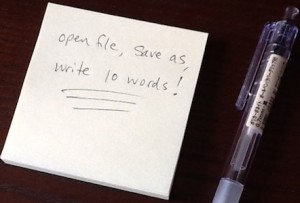An editor friend of mine recently commented that for her, writing is like exercise: she feels good once it’s over, but she finds it hard to start.
I agree on both counts. Starting anything is the hardest part.
My personal factory setting on any given morning, for example, is
- Get up.
- Make coffee in my pajamas.
- Check email and Facebook for about an hour.
If I don’t mess with these internal settings, this is my morning all year long. There are worse ways to greet the day, but if you’re trying to get into physical condition or write a book (both of which I am doing), following the path of least resistance is not a great idea. The definition of insanity is doing the same thing over and over and expecting a different outcome. If what you usually do isn’t turning out pages or clocking miles, clearly you need to make a change.
Several months ago, I initiated a writing process for myself that works pretty well. For me, it’s the equivalent of a fitness magazine’s advice to reluctant runners:
If you have trouble working out in the morning, lay your workout clothes out the night before.
If you’ve tried this method with exercise, you know it works. Rolling out of bed and seeing your shoes, socks, undergarments, shorts, t-shirt, and iPod removes the first hurdle of the day — assembling your outfit. Almost anyone can get dressed on autopilot without that first cup of coffee. Once the clothes are on and the shoes are tied, it’s an easy matter to walk out the door. Against your better judgment, you may even feel excited about moving around and getting your blood pumping.
You can replicate the same process with writing: lay your day’s work out the night before.
If you’re working on a magazine article or essay, for example, print out what you wrote today and put it on your desk so it’s the first thing you see tomorrow. Your editor’s mind will glance at your draft, critique it, and propel you to react to it in ways that will help you move forward on the next draft or section.
If you’re skipping around within a larger document, like a novel or a nonfiction book, consider a checklist of your top three project priorities for the week, then lay that list out beside a few notes about what you intend to work on during your next session. (E.g., “Outline a prologue” or “Make hand-written edits on a printout of Chapter 7.”)
Giving yourself a specific, finite assignment helps to remove the decision-making process from your writing practice. Because you left yourself advance instructions, you don’t need to waste the first fifteen minutes of your writing session rooting around for something to do. By giving yourself a narrow focus for the day (or hour, or fifteen minutes), you also reduce your chances of feeling overwhelmed at the task in front of you. In fact, I’ve found that the tinier the assignment, the more I’ll do. The part of me that likes showing off responds well to simple tasks. (“‘Come up with a character name?’ Pshaw! I’ll write an entire character dossier.”)
These little notes to self work just as well for the marketing side of writing. I recommend keeping a Submit List that runs parallel to your Writing Priorities List. This Submit List is a chronicle of places you’ll send your writing when it’s complete. Depending on your project, your Submit List may include literary agents, journals, magazines, or contests–or some combination therein. Think of the Submit List as your external pressure to reach your goal–the writer’s version of signing up for a 5k.
